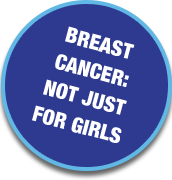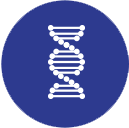

Breast cancer is diagnosed in more than50,000 women each year in the UK

Including 4,600 in Scotland alone.This makes it the second most common form of cancer (behind lung

and it’s believedone in eight will be diagnosed throughout their lifetime
This statistic is quite staggering, so it’s perhaps unsurprising breast cancer charities receive a wealth of funding each year in an effort to develop better treatment and highlight awareness.
A YouGov survey, commissioned by Insurancewith, found that whilst as many as 53% of people in the UK are worried about having cancer at some point in their life, only 44% of men share that concern. However, it’s not only women who can be diagnosed with this form of cancer. Men are also susceptible and whilst figures aren’t on the same level, it’s still important for males to understand the risks and symptoms.
Around 350 men are diagnosed in the UK each year,contributing to the thousands worldwide. And awareness is somewhat low on this subject – with many people not even realising it’s possible for men to be affected by this life-threatening cancer.
this guide we’ll offer a better understanding of breast cancer in general, before taking a closer look into how men are affected.

Fortunately, the survival rates for breast cancer have never been better. This is largely thanks to the improved awareness, screening and treatment methods now applied around the world. Around five in six women will now survive the cancer for at least five years.

However, that’s still not good enough. An estimated1,000 women will die of breast cancer each yearwith those over 40 more likely to be diagnosed.

Women over 50 have thebr highest chance of incidence

Women over 50 have thebr highest chance of incidence

According to breastcancer.org, the survival rate for women diagnosed was 83% in the initial five years.

For men, this figure is slightly worse at 74%.
Breast cancer is not a single disease, but instead makes up a number of variants that affect patients at different stages of the development and growth.
Primary breast cancer is the name given to the condition when it has not spread beyond the breast or lymph nodes under the arm. If a cancer is able to spread and affect other areas of the body, this is referred to as invasive. It’s important to mention that invasive breast cancer might not yet have spread – but instead simply has the potential to. Treatment will then be designed to prevent this occurring.
Breasts are made up of milk-producing glands (lobules) and tubes that carry the milk (ducts). These are then surrounded by glandular, fibrous and fatty tissues. When cells in the breast begin to divide and grow in somewhat abnormal ways, this is when cancerous activity is noted.
Because of the various ways these cells can divide and grow, there are a number of potential breast cancers a patient may be diagnosed with. As such, there’ll be a different treatment that’s deemed most appropriate.
This is an early form of breast cancer and DCIS (ductal carcinoma in situ) is a non-invasive variant. This cancer is found in the milk ducts and described as in situ, because it’ll remain in its place of origin by not having the potential to develop elsewhere. DCIS can affect both men and women.
However, if DCIS is left untreated, further problems can occur. It may spread to the surrounding breast tissue and invade other areas of the body too. Cases can be investigated individually to assess if DCIS will become invasive (monitoring type, size and grade), but there is no way of knowing for certain.
As mentioned above, invasive breast cancer has the potential to invade and attack other areas of the patient’s body. The most common form of invasive breast cancer is invasive ductal cancer (otherwise referred to as of no special type).
Invasive breast cancers include:
Invasive breast cancer of no special type: This could be written as NST or NOS (not otherwise specified) and accounts for around 75% of all breast cancer diagnosis.
Invasive lobular breast cancer: This could be written as NST or NOS (not otherwise specified) and accounts for around 75% of all breast cancer diagnosis.
Cribriform breast cancer: Only around 4% of cancers are diagnosed as cribriform, but this still accounts for many thousands of cases. Under a microscope it’s possible to see distinct holes in the cancer cells – with the appearance very much sieve-like.
Inflammatory breast cancer: Breast appears red and inflamed. The cancer is likely to spread quickly.
Mucinous carcinoma: An invasive form of cancer that is more common in women postmenopausal.
Phyllodes tumour: Leaf-like appearing tumour in the breast ducts.
Tubular carcinoma: A small tumour in the breast (often undetectable by palpitation).
Sarcomas: Connective tissue cancer that rarely affects the breasts.
Unfortunately, the risk factors of breast cancer are still very much unknown. However, for women there is scientific evidence pointing towards oestrogen that’s produced by the ovaries – mainly because of an association with certain reproductive system changes. For men, high levels of oestrogen have also been pencilled as a potential cause.

There’s also a train of thought regarding the genetic predisposition of patients. Molecular tests suggest people with BRCA1 and BRCA2 genetic susceptibility are more likely to develop breast cancer. BRCA1 and BRCA2 mutations are more common in those with Jewish ancestry.

Scientists suggest breast cancer is more likely to be found in those who have had first-degree relatives also diagnosed. As such, if breast cancer has been in the family it’s recommended to have early screening tests.

The likelihood of being diagnosed with breast cancer also increases as you get older. In total, around one in eight women will develop breast cancer, with risks more significant in those over 50 for men also.

It should also be noted that worldwide, there has been a correlation in breast cancer and diet. This is particularly associated with fat intake, although it’s important to state this has not been firmly established. Likewise, physical activity and maintaining a healthy body are believed to reduce the risks of developing breast cancer.
In order to diagnose breast cancer early in its development, it will be sighted on a mammogram – well before it can be felt by a patient or their healthcare provider.
However, once there are signs and symptoms, patients will typically notice one or more of the following:
A lump in the breast
Tenderness, skin irritation or dimpling
Nipple discharge or pain
Scaliness, ulceration or retraction
It’s important to consider though, that breast pain is usually as a result of benign conditions and not wholly associated with cancer.
As the cancer could have developed some way before noticeable symptoms emerge, this makes a mammography incredibly important. It will discover any abnormalities at an early stage and, as such, save lives and increase the potential treatment options.
For this very reason, it’s recommended for women aged 40 and over to have an annual inspection and for those between 20 and 39 to be checked out every three years. People should also perform a self-examination every month.
If a mammography results in unusual activity being noted, further tests will be required. Diagnosis will only be determined after suspicious lumps have been biopsied.

 GO TO THE CHAPTER 2: Understanding breast cancer in men
GO TO THE CHAPTER 2: Understanding breast cancer in men